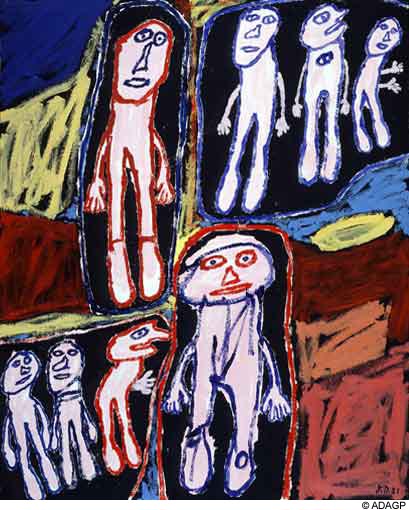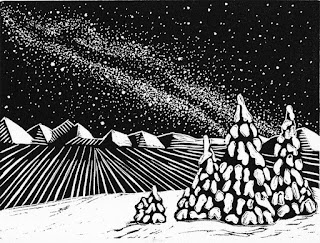Post War Abstract Expressionism and Pop Art
Post War Abstract Expressionism and Pop Art
Dubuffet, Jean. Site Visited. 1981. Wikiart,
Dubuffet, Jean. Cow With a Subtle Nose. 1954, Museum of Modern Art, NY, United States.
These two paintings are by Jean Dubuffet, a French painter who is most well known for starting the Art Brut movement. Dubuffet largely resented authority and never officially received an education in art. He would gain notoriety through his art which rejected the conventions of popular culture at the time. This is reflected in the ideology of the Art Brut movement which focusses on "Outsider art" by non-formally educated and trained artists. This style was created to reject the tropes and conventions which art followed- in essence promoting "less skilled" or conventionally talented artists. According to The Art Story, Dubuffet "described [mainstream culture] as "asphyxiating."," and "He was attracted to the art of children and the mentally ill, and did much to promote it". While I don't mean this disparagingly, I think that this is something that can be seen in his works. Dubuffet's paintings all have a childish, raw quality which reflect the most basic levels of an idea. Take for example "Cow With a Subtle Nose" which features a cow- a basic, almost laughably rough cow. This is an example of how the Art Brut style rejects the classical teachings and trainings of art to instead promote ideas in a less conventional style.
Pollock, Jackson. Autumn Rhythm (Number 30). 1950, The Metropolitan Museum of Art, NY, United States.
Pollock, Jackson. Number 5. 1948, private collection, NY, United States.
Jackson Pollock is an artist who emphasizes that the expression of art isn't just the reflection of a concept, but of the method of production. At first glance his paintings look like someone just threw paint of a canvas, and that isn't entirely untrue. Instead, Pollock's paintings are best known for their unique styles of creation. For example, "Autumn Rhythm" was created by laying canvas down on the floor and then painting it in a rather unique method. To quote, "Pollock used to drip and pour paint all over it, moving to the beat of his own inner rhythm, occasionally using towels and sticks to help him complete the painting" (Lee, 2016). Furthermore, according to Pollock himself, "Painting is a state of being... Painting is self-discovery. Every good artist paints what he is." This best represents Pollocks message: painting isn't about putting down that which you visualize- it's about putting down your understanding of something, your way of voicing the world that you see and understand, and- most importantly- how you express these things.
Lichtenstein, Roy. Whaam!. 1963, Tate Gallery, London.
Lichtenstein, Roy. In The Car. 1963, Scottish National Gallery of Modern Art, Edinburgh.
Conclusion
Of the style's and artists covered- Dubuffet's Art Brut, Pollock's abstract expressionism, and Lichtenstein's pop art- I most resonate with the comic-esque style of Lichtenstein. I love how it manages to create such a linear narrative while also leaving a lot up for interpretation- not to mention how visually cohesive and pleasing it is. I like the thought behind Pollock's work wherein the abstract expressionism is in the methods of creating the piece, but I find that I appreciate art that displays a clearer subject more. Lastly, I like the feel of rejecting traditions and norms that's expressed in Dubuffet's work, and the childish-fever dream feel that it asserts works well to challenge the conventions of the times. It's understandable why all of the artists were- in some way or another- credited as early proponents of their respective styles. If I had to say whose paintings I would rather have myself, it would definitely be Lichtenstein's. That being said, I think that both Dubuffet and Pollock's paintings serve as good conversation starters on what can be considered art, as well as the abstract narratives that art can tell.
Works Cited
Jean Dubuffet Paintings, Bio, Ideas. The Art Story. (n.d.). https://www.theartstory.org/artist/dubuffet-jean/
Berman, A. (n.d.). Biography. Roy Lichtenstein Foundation. https://lichtensteinfoundation.org/biography/#:~:text=Lichtenstein’s%20success%20was%20matched%20by,for%20their%20wit%20and%20invention









Comments
Post a Comment